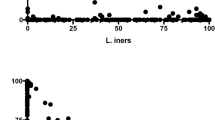Abstract
A total of 57 lactic acid bacteria were isolated from the vaginal secretions of 259 patients. Of these strains, 37 were isolated from patients attending pre-natal clinics and the remaining strains from patients attending post-natal clinics. The strains were identified by using simple physiological and biochemical tests and their phenotypic relatedness determined by numerical analysis of total soluble cell protein patterns. The genotypic relatedness of representative strains selected from each of the protein profile clusters was determined by numerical analysis of the DNA banding patterns obtained from RAPD-PCR. The majority of lactobacilli isolated belonged to the species Lactobacillus pentosus, Lactobacillus fermentum and Enterococcus faecium. A few strains of Lactobacillus plantarum and Weissella viridescens were also isolated. One strain, TV 1029, grouped into the same protein profile cluster as E. faecium, but revealed a DNA banding pattern closer related to Enterococcus faecalis. This is the first report of W. viridescens associated with the human vagina.
Similar content being viewed by others
References
Antonio M.A., Hawes S.E. and Hillier S.L. 1999. The identification of vaginal Lactobacillus species and the demographic and microbiologic characteristics of women colonized by these species. J. Infect. Dis. 180: 1950–1956.
Bartlett J.G., Onderdonk A.B., Drude E., Goldstein C., Anderka M., Alpert S.L. et al. 1977. Quantitative bacteriology of the vaginal flora. J. Infect. Dis. 136: 271.
Dicks L.M.T. 1985. Taxonomy and physiology of heterofermentative Lactobacillus species including isolates from South African red wines, MSc, University of Stellenbosch, Stellenbosch, South Africa.
Dicks L.M.T., Silvester M., Lawson P.A. and Collins M.D. 2000. Lactobacillus fornicalis sp. nov., isolated from the posterior fornix of the human vagina. Int. J. Syst. Evolut. Microbiol. 50: 1253–1258.
Dicks L.M.T. and Van Vuuren H.J.J. 1987. A modification of the hot-tube method for the detection of carbon dioxide produced by heterofermentative Lactobacillus strains. J. Microbiol. Meth. 6: 273–275.
Farooqui S., Wolf-Klein G.P., Silverstone F.A., Lee J., Orlow M. and Evans M. 1996. Vaginal flora in elderly females. J. Am. Ger. Soc. 44: 44.
Fernandes C.F., Shahani K.M. and Amer M.A. 1987. Therapeutic role of dietary lactobacilli and lactobacillic fermentated dairy products. FEMS Microbiol. Rev. 46: 343–356.
Fontaine E.A., Claydon E. and Taylor-Robinson D. 1996. Lactobacilli from women with or without bacterial vaginosis and observations on the significance of hydrogen peroxide. Microb. Ecol. Health Dis. 9: 135–141.
Freidrich E.A. Jr. 1979. The vagina: an ecological challenge. Ariz. Med. 36: 443–445.
Giorgi A., Torriani S., Dellaglio F., Bo G., Stola E. and Bernuzzi L. 1987. Identification of vaginal lactobacilli from asymptomatic women. Microbiologica 10: 377–384.
Gravett M.G., Nelson H.P. and DeRouen T. 1986. Independent association of bacterial vaginosis and Chlamydia trachomatis infection with adverse pregnancy outcome. JAMA 256: 1899–1903.
Hooton T.M., Fihn S.D., Johnson C., Roberts P.L. and Stamm W.E. 1989. Association between bacterial vaginosis and acute cystitis in women using diaphragms. Arch. Intern. Med. 149: 1932–1936.
Kilic A.O., Pavlova S.I., Alpay S., Kilic S.S. and Tao L. 2001. Comparative study of vaginal Lactobacillus phages isolated from women in the United States and Turkey: Prevalence, morphology, host range, and DNA homology. Clin. Diagn. Lab. Immunol. 8: 31–39.
Larsen B. and Galask R.P. 1980. Vaginal microflora: practical and theoretical relevance. Obstet. Gynecol. 55: 1005–1138.
Martius J., Krohn M.A., Hillier S.L., Stamm W.E., Holmes K.K. and Eschenbach D.A. 1988. Relationship of vaginal Lactobacillus species, cervical Chlamydia trachomatis and bacterial vaginosis to preterm birth. Obstet. Gynecol. 71: 89–95.
Nicolle L.E. 1994. Prevention and treatment of urinary catheter-related infections in older patients. Drugs Ageing 4: 379–391.
Redondo-Lopez V., Cook R.L. and Sobel J.D. 1990. Emerging role of lactobacilli in the control and maintenance of the vaginal bacterial microflora. Rev. Infect. Dis. 12: 856–872.
Silver H.M., Sperling R.S., St Clair P.J. and Gibbs R.S. 1989. Evidence relating bacterial vaginosis to intraamniotic infection. Am. J. Obstet. Gynecol. 161: 808–812.
Van Reenen C.A. and Dicks L.M.T. 1996. Evaluation of numerical analysis of random amplified polymorphic DNA (RAPD)-PCR as a method to differentiate Lactobacillus plantarum and Lactobacillus pentosus. Curr. Microbiol. 32: 183–187.
Vauterin L., Swings J. and Kersters K. 1993. Protein electrophoresis and classification. In: Goodfellow M. and O'Donnell A.G. (eds), Handbook of New Bacterial Systematics. Academic Press Inc., London, pp. 251–280.
Watts D.H., Krohn M.A., Hillier S.L. and Eschenbach D.A. 1990. Bacterial vaginosis as a risk factor for post-cesaraen endometritis. Obstet. Gynocol. 75: 52–58.
Wylie J.G. and Henderson A. 1969. Identity and glycogen-fermenting ability of lactobacilli isolated from the vagina of pregnant women. J. Med. Microbiol. 2: 363–366.
Wood B. and Holzapfel W.H. 1995. The Lactic Acid Bacteria, The Genera of Lactic Acid Bacteria. Blackie Academic & Professional, London. 2.
Author information
Authors and Affiliations
Corresponding author
Rights and permissions
About this article
Cite this article
Silvester, M., Dicks, L. Identification of lactic acid bacteria isolated from human vaginal secretions. Antonie Van Leeuwenhoek 83, 117–123 (2003). https://doi.org/10.1023/A:1023373023115
Issue Date:
DOI: https://doi.org/10.1023/A:1023373023115




